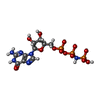[English] 日本語
 Yorodumi
Yorodumi- PDB-7lc2: Crystal Structure of KRAS4b-Q61R (GMPPNP-bound) in complex with t... -
+ Open data
Open data
- Basic information
Basic information
| Entry | Database: PDB / ID: 7lc2 | ||||||
|---|---|---|---|---|---|---|---|
| Title | Crystal Structure of KRAS4b-Q61R (GMPPNP-bound) in complex with the RAS-binding domain (RBD) of SIN1 | ||||||
 Components Components |
| ||||||
 Keywords Keywords | ONCOPROTEIN / Hydrolase / KRAS / RAS / K-RAS / Small GTPase / GMPPNP / GppNHp MAPKAP1 / mTORC2 / SIN1 / RBD | ||||||
| Function / homology |  Function and homology information Function and homology informationTORC2 signaling / TORC2 complex / regulation of cellular response to oxidative stress / phosphatidic acid binding / negative regulation of Ras protein signal transduction / serine/threonine protein kinase complex / phosphatidylinositol-3,4-bisphosphate binding / phosphatidylinositol-3,5-bisphosphate binding / response to mineralocorticoid / GMP binding ...TORC2 signaling / TORC2 complex / regulation of cellular response to oxidative stress / phosphatidic acid binding / negative regulation of Ras protein signal transduction / serine/threonine protein kinase complex / phosphatidylinositol-3,4-bisphosphate binding / phosphatidylinositol-3,5-bisphosphate binding / response to mineralocorticoid / GMP binding / forebrain astrocyte development / LRR domain binding / regulation of synaptic transmission, GABAergic / negative regulation of epithelial cell differentiation / response to isolation stress / response to gravity / epithelial tube branching involved in lung morphogenesis / Constitutive Signaling by AKT1 E17K in Cancer / type I pneumocyte differentiation / Rac protein signal transduction / phosphatidylinositol-3,4,5-trisphosphate binding / positive regulation of Rac protein signal transduction / Signaling by RAS GAP mutants / Signaling by RAS GTPase mutants / Activation of RAS in B cells / myoblast proliferation / RAS signaling downstream of NF1 loss-of-function variants / RUNX3 regulates p14-ARF / skeletal muscle cell differentiation / positive regulation of glial cell proliferation / SOS-mediated signalling / CD28 dependent PI3K/Akt signaling / Activated NTRK3 signals through RAS / Activated NTRK2 signals through RAS / SHC1 events in ERBB4 signaling / enzyme-substrate adaptor activity / cardiac muscle cell proliferation / Signalling to RAS / SHC-related events triggered by IGF1R / Activated NTRK2 signals through FRS2 and FRS3 / Estrogen-stimulated signaling through PRKCZ / SHC-mediated cascade:FGFR3 / cellular response to nutrient levels / MET activates RAS signaling / glial cell proliferation / SHC-mediated cascade:FGFR2 / Signaling by PDGFRA transmembrane, juxtamembrane and kinase domain mutants / Signaling by PDGFRA extracellular domain mutants / SHC-mediated cascade:FGFR4 / PTK6 Regulates RHO GTPases, RAS GTPase and MAP kinases / Erythropoietin activates RAS / SHC-mediated cascade:FGFR1 / Signaling by FGFR4 in disease / Signaling by CSF3 (G-CSF) / FRS-mediated FGFR3 signaling / Signaling by FLT3 ITD and TKD mutants / FRS-mediated FGFR2 signaling / FRS-mediated FGFR4 signaling / p38MAPK events / Signaling by FGFR3 in disease / FRS-mediated FGFR1 signaling / protein-membrane adaptor activity / Tie2 Signaling / striated muscle cell differentiation / Signaling by FGFR2 in disease / phosphatidylinositol-4,5-bisphosphate binding / cytoskeleton organization / GRB2 events in EGFR signaling / Signaling by FLT3 fusion proteins / SHC1 events in EGFR signaling / FLT3 Signaling / Signaling by FGFR1 in disease / EGFR Transactivation by Gastrin / NCAM signaling for neurite out-growth / CD209 (DC-SIGN) signaling / substantia nigra development / GRB2 events in ERBB2 signaling / negative regulation of insulin receptor signaling pathway / Downstream signal transduction / homeostasis of number of cells within a tissue / Insulin receptor signalling cascade / SHC1 events in ERBB2 signaling / Ras activation upon Ca2+ influx through NMDA receptor / response to glucocorticoid / Constitutive Signaling by Overexpressed ERBB2 / Signaling by phosphorylated juxtamembrane, extracellular and kinase domain KIT mutants / VEGFR2 mediated cell proliferation / small monomeric GTPase / VEGFR2 mediated vascular permeability / FCERI mediated MAPK activation / liver development / Signaling by ERBB2 TMD/JMD mutants / female pregnancy / RAF activation / Signaling by SCF-KIT / Constitutive Signaling by EGFRvIII / Signaling by high-kinase activity BRAF mutants / MAP2K and MAPK activation / regulation of long-term neuronal synaptic plasticity / Signaling by ERBB2 ECD mutants Similarity search - Function | ||||||
| Biological species |  Homo sapiens (human) Homo sapiens (human) | ||||||
| Method |  X-RAY DIFFRACTION / X-RAY DIFFRACTION /  SYNCHROTRON / SYNCHROTRON /  MOLECULAR REPLACEMENT / Resolution: 2.7 Å MOLECULAR REPLACEMENT / Resolution: 2.7 Å | ||||||
 Authors Authors | Dharmaiah, S. / Simanshu, D.K. | ||||||
| Funding support |  United States, 1items United States, 1items
| ||||||
 Citation Citation |  Journal: Proc.Natl.Acad.Sci.USA / Year: 2021 Journal: Proc.Natl.Acad.Sci.USA / Year: 2021Title: RAS interaction with Sin1 is dispensable for mTORC2 assembly and activity. Authors: Castel, P. / Dharmaiah, S. / Sale, M.J. / Messing, S. / Rizzuto, G. / Cuevas-Navarro, A. / Cheng, A. / Trnka, M.J. / Urisman, A. / Esposito, D. / Simanshu, D.K. / McCormick, F. | ||||||
| History |
|
- Structure visualization
Structure visualization
| Structure viewer | Molecule:  Molmil Molmil Jmol/JSmol Jmol/JSmol |
|---|
- Downloads & links
Downloads & links
- Download
Download
| PDBx/mmCIF format |  7lc2.cif.gz 7lc2.cif.gz | 208.4 KB | Display |  PDBx/mmCIF format PDBx/mmCIF format |
|---|---|---|---|---|
| PDB format |  pdb7lc2.ent.gz pdb7lc2.ent.gz | 166.3 KB | Display |  PDB format PDB format |
| PDBx/mmJSON format |  7lc2.json.gz 7lc2.json.gz | Tree view |  PDBx/mmJSON format PDBx/mmJSON format | |
| Others |  Other downloads Other downloads |
-Validation report
| Summary document |  7lc2_validation.pdf.gz 7lc2_validation.pdf.gz | 1.6 MB | Display |  wwPDB validaton report wwPDB validaton report |
|---|---|---|---|---|
| Full document |  7lc2_full_validation.pdf.gz 7lc2_full_validation.pdf.gz | 1.6 MB | Display | |
| Data in XML |  7lc2_validation.xml.gz 7lc2_validation.xml.gz | 20.3 KB | Display | |
| Data in CIF |  7lc2_validation.cif.gz 7lc2_validation.cif.gz | 26.8 KB | Display | |
| Arichive directory |  https://data.pdbj.org/pub/pdb/validation_reports/lc/7lc2 https://data.pdbj.org/pub/pdb/validation_reports/lc/7lc2 ftp://data.pdbj.org/pub/pdb/validation_reports/lc/7lc2 ftp://data.pdbj.org/pub/pdb/validation_reports/lc/7lc2 | HTTPS FTP |
-Related structure data
| Related structure data |  7lc1C 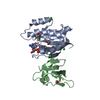 6vjjS S: Starting model for refinement C: citing same article ( |
|---|---|
| Similar structure data |
- Links
Links
- Assembly
Assembly
| Deposited unit | 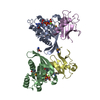
| ||||||||
|---|---|---|---|---|---|---|---|---|---|
| 1 | 
| ||||||||
| 2 | 
| ||||||||
| Unit cell |
|
- Components
Components
| #1: Protein | Mass: 19545.459 Da / Num. of mol.: 2 / Mutation: Q61R Source method: isolated from a genetically manipulated source Source: (gene. exp.)  Homo sapiens (human) / Gene: KRAS, KRAS2, RASK2 / Production host: Homo sapiens (human) / Gene: KRAS, KRAS2, RASK2 / Production host:  #2: Protein | Mass: 9824.110 Da / Num. of mol.: 2 Source method: isolated from a genetically manipulated source Source: (gene. exp.)  Homo sapiens (human) / Gene: MAPKAP1, MIP1, SIN1 / Production host: Homo sapiens (human) / Gene: MAPKAP1, MIP1, SIN1 / Production host:  #3: Chemical | #4: Chemical | #5: Water | ChemComp-HOH / | Has ligand of interest | Y | Has protein modification | Y | |
|---|
-Experimental details
-Experiment
| Experiment | Method:  X-RAY DIFFRACTION / Number of used crystals: 1 X-RAY DIFFRACTION / Number of used crystals: 1 |
|---|
- Sample preparation
Sample preparation
| Crystal | Density Matthews: 2.34 Å3/Da / Density % sol: 47.48 % |
|---|---|
| Crystal grow | Temperature: 293 K / Method: vapor diffusion, hanging drop / pH: 5 Details: 100mM MMT buffer (DL-malic acid, MES and Tris base in 1:2:2 ratio) pH 5, 25% PEG (polyethylene glycol) 1500 |
-Data collection
| Diffraction | Mean temperature: 100 K / Serial crystal experiment: N | ||||||||||||||||||||||||||||||||||||||||||||||||||||||||||||||||||||||||||||||||||||||||||||||||||||||||||||||
|---|---|---|---|---|---|---|---|---|---|---|---|---|---|---|---|---|---|---|---|---|---|---|---|---|---|---|---|---|---|---|---|---|---|---|---|---|---|---|---|---|---|---|---|---|---|---|---|---|---|---|---|---|---|---|---|---|---|---|---|---|---|---|---|---|---|---|---|---|---|---|---|---|---|---|---|---|---|---|---|---|---|---|---|---|---|---|---|---|---|---|---|---|---|---|---|---|---|---|---|---|---|---|---|---|---|---|---|---|---|---|---|
| Diffraction source | Source:  SYNCHROTRON / Site: SYNCHROTRON / Site:  APS APS  / Beamline: 24-ID-E / Wavelength: 0.97918 Å / Beamline: 24-ID-E / Wavelength: 0.97918 Å | ||||||||||||||||||||||||||||||||||||||||||||||||||||||||||||||||||||||||||||||||||||||||||||||||||||||||||||||
| Detector | Type: DECTRIS EIGER X 16M / Detector: PIXEL / Date: Aug 3, 2017 | ||||||||||||||||||||||||||||||||||||||||||||||||||||||||||||||||||||||||||||||||||||||||||||||||||||||||||||||
| Radiation | Protocol: SINGLE WAVELENGTH / Monochromatic (M) / Laue (L): M / Scattering type: x-ray | ||||||||||||||||||||||||||||||||||||||||||||||||||||||||||||||||||||||||||||||||||||||||||||||||||||||||||||||
| Radiation wavelength | Wavelength: 0.97918 Å / Relative weight: 1 | ||||||||||||||||||||||||||||||||||||||||||||||||||||||||||||||||||||||||||||||||||||||||||||||||||||||||||||||
| Reflection | Resolution: 2.7→45.47 Å / Num. obs: 15142 / % possible obs: 99.5 % / Redundancy: 6.635 % / Biso Wilson estimate: 74.424 Å2 / CC1/2: 0.997 / Rmerge(I) obs: 0.102 / Rrim(I) all: 0.111 / Χ2: 0.877 / Net I/σ(I): 11.57 / Num. measured all: 100465 | ||||||||||||||||||||||||||||||||||||||||||||||||||||||||||||||||||||||||||||||||||||||||||||||||||||||||||||||
| Reflection shell | Diffraction-ID: 1
|
- Processing
Processing
| Software |
| |||||||||||||||||||||||||||||||||||||||||||||||||||||||||||||||||||||||||||||||||||||||||||||||||||||||||||||||||||||||||||||
|---|---|---|---|---|---|---|---|---|---|---|---|---|---|---|---|---|---|---|---|---|---|---|---|---|---|---|---|---|---|---|---|---|---|---|---|---|---|---|---|---|---|---|---|---|---|---|---|---|---|---|---|---|---|---|---|---|---|---|---|---|---|---|---|---|---|---|---|---|---|---|---|---|---|---|---|---|---|---|---|---|---|---|---|---|---|---|---|---|---|---|---|---|---|---|---|---|---|---|---|---|---|---|---|---|---|---|---|---|---|---|---|---|---|---|---|---|---|---|---|---|---|---|---|---|---|---|
| Refinement | Method to determine structure:  MOLECULAR REPLACEMENT MOLECULAR REPLACEMENTStarting model: 6VJJ Resolution: 2.7→45.47 Å / SU ML: 0.4 / Cross valid method: THROUGHOUT / σ(F): 1.35 / Phase error: 31.03 / Stereochemistry target values: ML
| |||||||||||||||||||||||||||||||||||||||||||||||||||||||||||||||||||||||||||||||||||||||||||||||||||||||||||||||||||||||||||||
| Solvent computation | Shrinkage radii: 0.9 Å / VDW probe radii: 1.11 Å / Solvent model: FLAT BULK SOLVENT MODEL | |||||||||||||||||||||||||||||||||||||||||||||||||||||||||||||||||||||||||||||||||||||||||||||||||||||||||||||||||||||||||||||
| Displacement parameters | Biso max: 155.46 Å2 / Biso mean: 85.179 Å2 / Biso min: 30 Å2 | |||||||||||||||||||||||||||||||||||||||||||||||||||||||||||||||||||||||||||||||||||||||||||||||||||||||||||||||||||||||||||||
| Refinement step | Cycle: final / Resolution: 2.7→45.47 Å
| |||||||||||||||||||||||||||||||||||||||||||||||||||||||||||||||||||||||||||||||||||||||||||||||||||||||||||||||||||||||||||||
| LS refinement shell | Refine-ID: X-RAY DIFFRACTION / Rfactor Rfree error: 0 / Total num. of bins used: 11 / % reflection obs: 100 %
| |||||||||||||||||||||||||||||||||||||||||||||||||||||||||||||||||||||||||||||||||||||||||||||||||||||||||||||||||||||||||||||
| Refinement TLS params. | Method: refined / Refine-ID: X-RAY DIFFRACTION
| |||||||||||||||||||||||||||||||||||||||||||||||||||||||||||||||||||||||||||||||||||||||||||||||||||||||||||||||||||||||||||||
| Refinement TLS group |
|
 Movie
Movie Controller
Controller





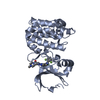
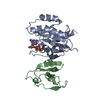
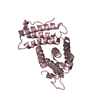
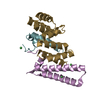
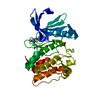

 PDBj
PDBj




















